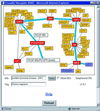BIND--The Biomolecular Interaction Network Database
- PMID: 11125103
- PMCID: PMC29820
- DOI: 10.1093/nar/29.1.242
BIND--The Biomolecular Interaction Network Database
Abstract
The Biomolecular Interaction Network Database (BIND; http://binddb. org) is a database designed to store full descriptions of interactions, molecular complexes and pathways. Development of the BIND 2.0 data model has led to the incorporation of virtually all components of molecular mechanisms including interactions between any two molecules composed of proteins, nucleic acids and small molecules. Chemical reactions, photochemical activation and conformational changes can also be described. Everything from small molecule biochemistry to signal transduction is abstracted in such a way that graph theory methods may be applied for data mining. The database can be used to study networks of interactions, to map pathways across taxonomic branches and to generate information for kinetic simulations. BIND anticipates the coming large influx of interaction information from high-throughput proteomics efforts including detailed information about post-translational modifications from mass spectrometry. Version 2.0 of the BIND data model is discussed as well as implementation, content and the open nature of the BIND project. The BIND data specification is available as ASN.1 and XML DTD.
Figures

References
-
- Mendelsohn A.R. and Brent,R. (1999) Protein interaction methods–toward an endgame. Science, 284, 1948–1950. - PubMed
-
- Cassman M., Hunter,T. and Pawson,T. (2000) Proteins suggest form of their own database. Nature, 403, 591–592. - PubMed
-
- Pawson T. (1995) Protein modules and signalling networks. Nature, 373, 573–580. - PubMed
-
- Ostell J. and Kans,J.A. (1998) In Baxevanis,A.D. and Ouellette,B.F. (eds), Bioinformatics, A Practical Guide to the Analysis of Genes and Proteins. John Wiley and Sons, New York, NY. Vol. 39, pp. 121–144.
Publication types
MeSH terms
Substances
LinkOut - more resources
Full Text Sources
Other Literature Sources
Molecular Biology Databases

